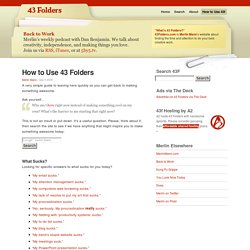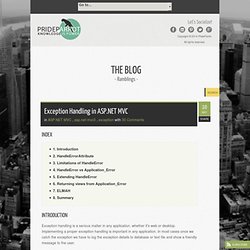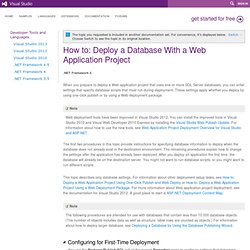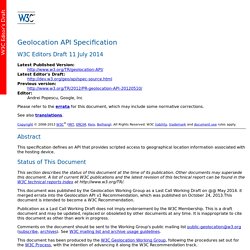

How to Use 43 Folders. A very simple guide to leaving here quickly so you can get back to making something awesome.

Ask yourself… Why am I here right now instead of making something cool on my own? What’s the barrier to me starting that right now? This is not an insult or put-down. It’s a useful question. What Sucks? Looking for specific answers to what sucks for you today? More ideas Still sucking? Still Lost? Try a mental sweep, do a shitty first draft, or consider a modest change. Maybe just get away from the computer for a while by taking a nice walk. How to Know When You’re Done Here You’re done here whenever you’ve found just enough information to get you back on track for today.
We love having you visit with us here, and we hope you’ll return many times — whenever you think we might have something that might help you get over the hump. The Only “Productivity” That Matters “Productivity” isn’t about about making more widgets per hour or being efficient and organized for its own anal-retentive sake. Petit Web - Le décodeur du numérique. Exception Handling in ASP.NET MVC.
Index Introduction Exception handling is a serious matter in any application, whether it's web or desktop.

Implementing a proper exception handling is important in any application. In most cases once we catch the exception we have to log the exception details to database or text file and show a friendly message to the user. In ASP.NET applications, error handling is done mostly in two ways: at local level using try-catch blocks and at global level using application events. In this article, we will learn about the HandleError filter and discuss about the different exception handling mechanisms that will fit to an MVC application.
HandleError Attribute Exception filters The exception filters are attributes that can be applied over an action or a controller or even at a global level. All the exception filters implements the IExceptionFilter interface. Listing 1. The HandleErrorAttribute is the default implementation of the IExceptionFilter. Listing 2. What the HandleError filter does? Error View. Marc Andreessen on Why Software Is Eating the World. Www.valvesoftware.com/company/Valve_Handbook_LowRes.pdf. How to: Deploy a Database With a Web Application Project. The topic you requested is included in another documentation set.

For convenience, it's displayed below. Choose Switch to see the topic in its original location. When you prepare to deploy a Web application project that uses one or more SQL Server databases, you can enter settings that specify database scripts that must run during deployment. These settings apply whether you deploy by using one-click publish or by using a Web deployment package. The first two procedures in this topic provide instructions for specifying database information to deploy when the database does not already exist in the destination environment.
You use the Package/Publish SQL tab of the project Properties page to configure settings that determine which scripts will run during deployment. Building Single Page Apps for desktop, mobile and tablet with ASP.NET MVC 4. Geolocation API Specification. Abstract This specification defines an API that provides scripted access to geographical location information associated with the hosting device.

Status of This Document This section describes the status of this document at the time of its publication. Other documents may supersede this document. A list of current W3C publications and the latest revision of this technical report can be found in the W3C technical reports index at This document was published by the Geolocation Working Group as a Last Call Working Draft on @@ May 2014. it merged errata into the Geolocation API v1 Recommendation, which was published on October 24, 2013.This document is intended to become a W3C Recommendation. Publication as a Last Call Working Draft does not imply endorsement by the W3C Membership.
Comments on the document should be sent to the Working Group's public mailing list public-geolocation@w3.org (subscribe, archives). Table of Contents 1 Conformance requirements 2 Introduction 3 Scope 5 API Description The. How to: Protect Against Script Exploits in a Web Application by Applying HTML Encoding to Strings. Most scripting exploits occur when users can get executable code (or script) into your application.

By default, ASP.NET provides request validation, which raises an error if a form post contains any HTML. You can help protect against script exploits in the following ways: Perform parameter validation on form variables, query-string variables, and cookie values. This validation should include two types of verification: verification that the variables can be converted to the expected type (for example, convert to an integer, convert to date-time, and so on), and verification of expected ranges or formatting.
For example, a form post variable that is intended to be an integer should be checked with the Int32.TryParse method to verify the variable really is an integer. HTML encoding converts HTML elements using HTML–reserved characters so that they are displayed rather than executed. Web API. Evolutionary/Agile Database Best Practices.